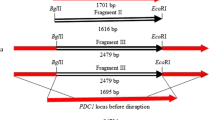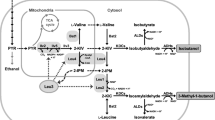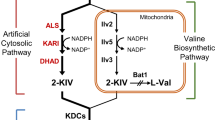Abstract
To investigate effects of different pyruvate decarboxylases on isobutanol titers in Saccharomyces cerevisiae, single-gene deletion of the three PDCs genes encoding pyruvate decarboxylases were constructed in this study. In addition, we over-expressed Ilv2, which catalyzed the first step in the valine synthetic pathway, and Bat2, which was the cytoplasmic branched-chain amino-acid aminotransferase that catalyzed L-valine to 2-ketoisovalerate, to increase isobutanol production in the genetically modified strains. Our results showed that knockout of PDC5 were one of the main factors among the three PDC genes for improving isobutanol titers in S. cerevisiae. Additionally, we found that deletion of PDC5 in strain carrying overexpressed ILV2 and ARO10 resulted in 8-fold higher isobutanol productivity as compared to the control strain in micro-aerobic fermentations. Our results also suggested that engineered strain pdc5ΔpILV2 pARO10 generated lower ethanol titers and higher acetate acid titers than the control strain, while the growth rate and glucose consumption rate of engineered strain pdc5ΔpILV2 pARO10 were slightly lower than that of the control strain. Meanwhile, the biomass concentration of pdc5ΔpILV2 pARO10 decreased dramatically than that of the control strain.
Similar content being viewed by others
References
Weber, C., A. Farwick, F. Benisch, D. Brat, H. Dietz, T. Subtil, and E. Boles (2010) Trends and challenges in the microbial production of lignocellulosic bioalcohol fuels. Appl. Microbiol. Biotechnol. 87: 1303–1315.
Ehrlich, F. (1907) Über die bedingungen der fuselölbildung und über ihren zusammenhang mit dem eiweissaufbau der hefe. Berichte der deutschen Chemischen Gesellschaft (Eur. J. Inorg. Chem.) 40: 1027–1047.
Hazelwood, L. A., J. M. Daran, A. J. van Maris, J. T. Pronk, and J. R. Dickinson (2008) The Ehrlich pathway for fusel alcohol production: A century of research on Saccharomyces cerevisiae metabolism. Appl. Environ. Microbiol. 74: 2259–2266.
Chen, X., K. F. Nielsen, I. Borodina, M. C. Kielland-Brandt, and K. Karhumaa (2011) Increased isobutanol production in Saccharomyces cerevisiae by overexpression of genes in valine metabolism. Biotechnol. Biofuels 4: 21–22.
Zhang, A. L., Y. Li, Y. H. Gao, and H. X. Jin (2016) Increasing isobutanol yield by double-gene deletion of PDC6 and LPD1 in Saccharomyces cerevisiae. Chin. J. Chem. Eng. 24: 1074–1079.
Zhang, A. L., Y. H. Gao, J. Z. Li, and H. X. Jin (2016) Effect of GPD2 and PDC6 deletion on isobutanol titer in Saccharomyces cerevisiae. Appl. Microbiol. Open Access 2: 112. doi:10.4172/amoa.1000112.
Kispal, G., H. Steiner, D. A. Court, B. Rolinski, and R. Lill (1996) Mitochondrial and cytosolic branched-chain amino acid transaminases from yeast, homologs of the myc oncogene-regulated Eca39 protein. J. Biol. Chem. 271: 24458–24464.
Velasco, J. A., J. Cansado, M. C. Pena, T. Kawakami, J. Laborda, and V. Notario (1993) Cloning of the dihydroxyacid dehydrataseencoding gene (ILV3) from Saccharomyces cerevisiae. Gene 137: 179–185.
Lee, W. H., S. O. Seo, Y. H. Bae, H. Nan, Y. S. Jin, and J. H. Seo (2012) Isobutanol production in engineered Saccharomyces cerevisiae by overexpression of 2-ketoisovalerate decarboxylase and valine biosynthetic enzymes. Bioproc. Biosyst. Eng. 35: 1467–1475.
Brat, D., C. Weber, W. Lorenzen, H. B. Bode, and E. Boles (2012) Cytosolic re-localization and optimization of valine synthesis and catabolism enables increased isobutanol production with the yeast Saccharomyces cerevisiae. Biotechnol. Biofuels 5: 65–70.
Avalos, J. L., G. R. Fink, and G. Stephanopoulos (2013) Compartmentalization of metabolic pathways in yeast mitochondria improves the production of branched-chain alcohols. Nat. Biotechnol. 31: 335–343.
Matsuda, F., J. Ishii, T. Kondo, K. Ida, H. Tezuka, and A. Kondo (2013) Increased isobutanol production in Saccharomyces cerevisiae by eliminating competing pathways and resolving cofactor imbalance. Microb. Cell Fact. 12: 119–129.
Hohmann, S. and H. Cederberg (1990) Autoregulation may control the expression of yeast pyruvate decarboxylase structural genes PDC1 and PDC5. Eur. J. Biochem. 188: 615–621.
Hohmann, S. (1991) PDC6, a weakly expressed pyruvate decarboxylase gene from yeast, is activated when fused spontaneously under the control of the PDC1 promoter. Curr. Genet 20: 373–378.
Agarwal, P. K., V. Uppada, and S. B. Noronha (2013) Comparison of pyruvate decarboxylases from Saccharomyces cerevisiae and Komagataella pastoris (Pichia pastoris). Appl. Microbiol. Biotechnol. 97: 9439–9449.
Kondo, T., H. Tezuka, J. Ishii, F. Matsuda, C. Ogino, and A. Kondo (2012) Genetic engineering to enhance the Ehrlich pathway and alter carbon flux for increased isobutanol production from glucose by Saccharomyces cerevisiae. J. Biotechnol. 159: 32–37.
Thomas, B. J. and R. Rothstein (1989) Elevated recombination rates in transcriptionally active DNA. Cell 56: 619–663.
Burke, D., D. Dawson, and T. Stearns (2000) Methods in Yeast Genetics: A Cold Spring Harbor Laboratory Course Manual. Cold Spring Harbor Laboratory Press, NY, USA.
Kong, Q. X., L. M. Cao, A. L. Zhang, and X. Chen (2007) Overexpressing GLT1 in gpd1Δ mutant to improve the production of ethanol of Saccharomyces cerevisiae. Appl. Microbiol. Biotechnol. 73: 1382–1386.
Author information
Authors and Affiliations
Corresponding author
Rights and permissions
About this article
Cite this article
Li, J., Feng, R., Wen, Z. et al. Overexpression of ARO10 in pdc5Δmutant resulted in higher isobutanol titers in Saccharomyces cerevisiae . Biotechnol Bioproc E 22, 382–389 (2017). https://doi.org/10.1007/s12257-017-0028-0
Received:
Revised:
Accepted:
Published:
Issue Date:
DOI: https://doi.org/10.1007/s12257-017-0028-0




